


Let \(\alpha\) be the complex number \(\alpha = e^{\theta i}=\cos{\theta} + i \sin{\theta}\). We can represent the trunk of the tree by the complex number \(i\) (which we can also think of geometrically as a vector). Recall that multiplying a vector by r will scale the vector by r, that multiplying the vector by \(\alpha\) corresponds to a counterclockwise rotation by θ, and multiplying by \(\alpha^{-1}\) corresponds to a clockwise rotation by θ. We also have \(\alpha^n = e^{n\theta i}=\cos{(n\theta)} + i \sin{(n\theta)}\) and \(\alpha^{-n} = e^{-n\theta i}=\cos{(n\theta)} - i \sin{(n\theta)}\) for all integers n.
\( \left(i + i r \alpha^{-1} + i r^2 \alpha^{-2} + \ldots + i r^k \alpha^{-k}\right) + i r^k \alpha^{-k} \cdot \left( {r \alpha + r^2 + r^3 \alpha + r^4 + \dots} \right) \) \[ \begin{align} &= i \left( \sum_{n=0}^{k}{r^n \alpha^{-n}} + r^k \alpha^{-k} \cdot \left( \dfrac{ra}{1-r^2} + \frac{r^2}{1-r^2} \right) \right) \\ \\ &= i \left( \sum_{n=0}^{k}{r^n \alpha^{-n}} + \frac{r^{k+1}\alpha^{-(k-1)} + r^{k+2}\alpha^{-k}}{1-r^2} \right) = iz. \end{align} \]
The y-coordinate of this branch tip is \(\text{Im}(iz) = \text{Re}(z)\), or
\[ \sum_{n=0}^{k}{r^n \cos(n \theta)} + \frac{r^{k+1} \cos((k-1)\theta) + r^{k+2} \cos(k \theta)}{1-r^2}. \] Here is an example with θ = 55°, so k = 4. The image on the left shows the R4(LR)∞ path while the image on the right shows the actual tree. The y-coordinate of the R4(LR)∞ branch tip is y = 0.53212.
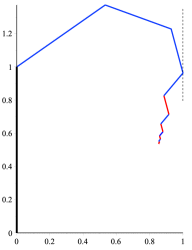
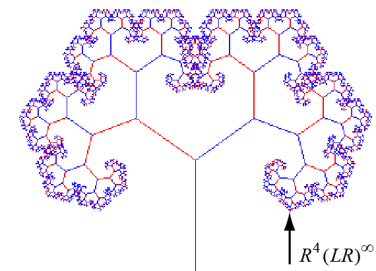
R4(LR)∞ path, θ = 55°, r = 0.65
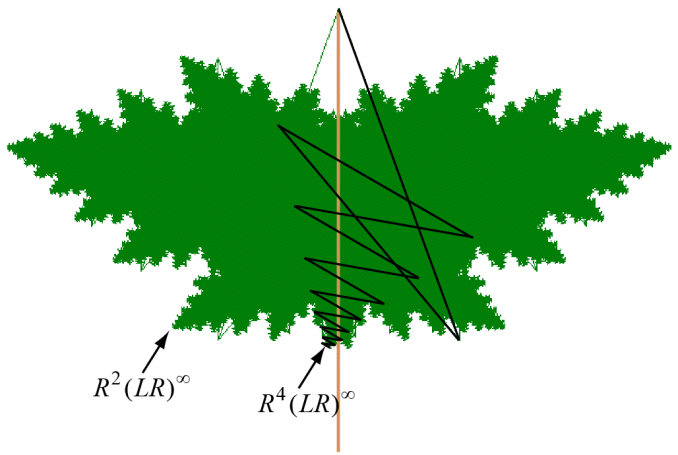
θ = 160°, r = 0.8
In this case the black path is of the form Rm(LR)∞ where m is the smallest integer satisfying mθ ≥ 540°. In essence, the black path starts with enough right turns until the last branch has passed the downward vertical direction for the second time before it begins to alternate between left and right branch turns.
Note that \(f_\theta (0) = 0\). It can be shown [Details] that for r close to 0, the graph of \(f_\theta (r)\) will initially begin increasing in a concave up fashion as r increases, and thus \(f_\theta (r)\) will be positive for r close to 0. Below are examples of the three things that can happen with the graph of \(f_\theta (r)\) for 0 < r < 1:
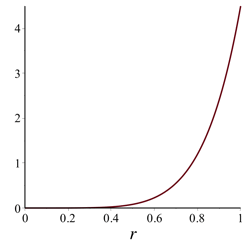
|
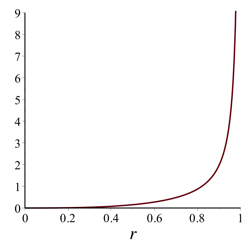
|
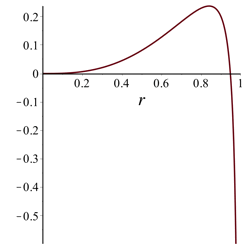
|
|
θ = 60° \(\lim_{r \rightarrow 1^{-}} f_\theta (r) = A_\theta > 0\) |
θ = 135° \(\lim_{r \rightarrow 1^{-}} f_\theta (r) = +\infty\) |
θ = 146° \(\lim_{r \rightarrow 1^{-}} f_\theta (r) = -\infty\) |
To see why, we need to examine the behavior of the numerator of the fraction in the expression for \(f_\theta (r)\) when r = 1 since the denominator is positive and goes to 0 as r approaches 1 from the left. So we need to determine the sign of \[ N(\theta) = \cos((m-1)\theta) + \cos(m \theta) -\cos((k-1)\theta) -\cos(k \theta) \] where \(k = \lceil \frac{180}{\theta}\rceil\) and \(m = \lceil \frac{540}{\theta} \rceil\), in particular whether N(θ) is 0, positive, or negative (corresponding to the three graphs above).
Below is the graph of \(N(\theta)\) showing that \(N(\theta)\) alternates between intervals where it is positive and intervals where it is negative (with those intervals getting smaller and alternating more rapidly as θ approaches 0.)

Here are closer views of the graph on the intervals 40° ≤ θ ≤ 90° and 90° ≤ θ ≤ 180°.
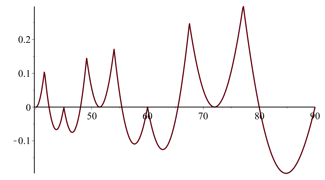
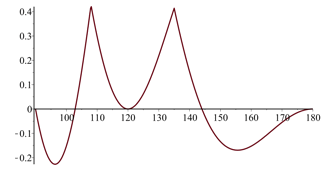
The places where the graph has a sharp corner are where \(\theta = \dfrac{540^\circ}{p}\) for an integer p ≥ 4.
The zeros of N(θ) occur at \(\theta = \dfrac{720^\circ}{p}\) for all integers p ≥ 4 [Proof]. Starting at the right end of the graph and going in decreasing order, the first four zeros are at 180°, 144°, 120°, and 102.85714°.
If θ is a zero of N(θ), then \(\lim_{r \rightarrow 1^{-}} f_\theta (r)\) exists and is positive [Proof]. Where N(θ) is positive we have \(\lim_{r \rightarrow 1^{-}} f_\theta (r) = +\infty\). For these values of θ, therefore, \(f_\theta (r) > 0\) for all 0 < r < 1 and hence yk will be less than ym.
The intervals where N(θ) is negative are of the form
\[ \frac{720^\circ}{4n+5} < \theta < \frac{720^\circ}{4n+4} \text{ and } \frac{720^\circ}{4n+4} < \theta < \frac{720^\circ}{4n+3} \] for \(n = 0,1,2, \ldots\). (For n = 0, only the first interval is used. This gives \(144^\circ < \theta < 180^\circ\).)On these intervals, we have \(f_\theta (r)\) positive for small r and \(\lim_{r \rightarrow 1^{-}} f_\theta (r) = -\infty\), so there must be some some rB between 0 and 1 where \(f_\theta (r_B) = 0.\)
The equation \(f_\theta (r) = 0\) can be solved numerically to find the solution rB. This equation will also have a solution on the intervals where N(θ) is positive, but for those values of θ, rB will be greater than 1. The next two figures show the graph of rB for 0° < θ < 180°, and a close up of this graph just on the range 30° < θ < 102.85714° (= 720°/7).
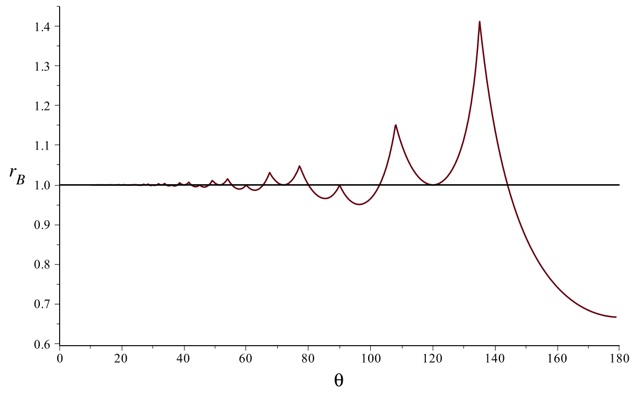

The intervals where N(θ) < 0 correspond to the intervals in these graphs where rB < 1. On these intervals, the bottom of the symmetric binary tree will be ym instead of yk for rB < r < 1.
Notice, however, that when θ < 102.85714°, the value of the critical scaling factor rB is greater than 0.95 so that for all practical purposes the bottom of a "reasonable" symmetric binary tree will be determined by the Rk(LR)∞ path. Any choice of r > 0.95 will produce a tree that has a massive overlap of branches. Only on the interval θ > 144° is there an opportunity for rB to be small enough that one can generate an interesting tree (see, for example, the tree above with θ = 160° and r = 0.8.) We actually have \[ r_B = \frac{2\cos(\theta)}{1-4\cos^2 (\theta)} \] for θ > 144° [Maple Calculation]. So rB converges to 2/3 as θ approaches 180°.